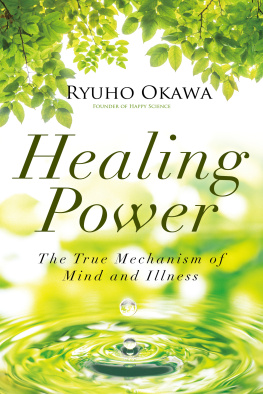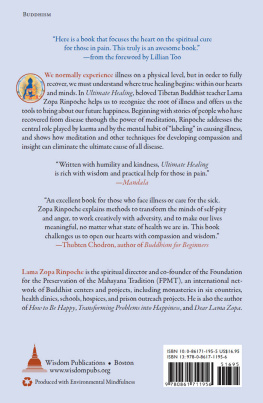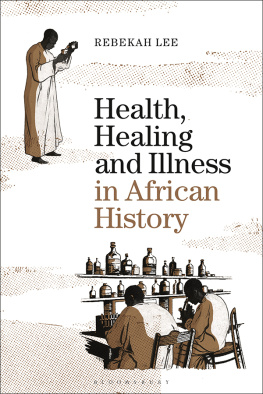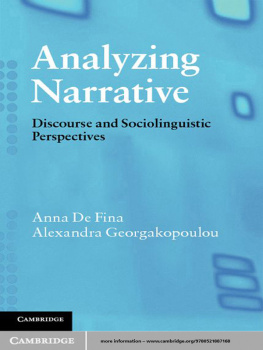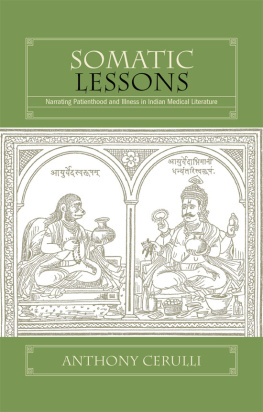Narrative and the Cultural Construction
of Illness and Healing
Cheryl Mattingly
and
Linda Garro
- (p.iv) University of California Press
- Berkeley and Los Angeles, California
- University of California Press, Ltd.
- London, England
- 2000 by the Regents of the University of California
- Library of Congress Cataloging-in-Publication Data
- Narrative and the cultural construction of illness
- and healing / edited by Cheryl Mattingly and
- Linda C. Garro.
- p. cm.
- Includes bibliographical references and index.
- ISBN 9780520218253
- 1. Social medicine. 2. Medical anthropology.
- 3. Discourse analysis, Narrative. 4. Medicine and
- psychology. I. Mattingly, Cheryl. II. Garro,
- Linda C.
- RA418.N36 2000
- 306.461dc21 00-031629
- Manufactured in the United States of America
- The paper used in this publication meets the minimum
- requirements of ANSI/NISO Z39.481992. (R
- 1997) (Permanence of Paper).
Dedication
(p.v) For Bill and Robert (p.vi)
(p.ix) Acknowledgments
We are indebted to Arthur Kleinman, Byron Good, and Mary-Jo DelVecchio Good for bringing us together through the Harvard Friday Morning Seminar in medical anthropology. This seminar provided the intellectual environment in which our collaborative work on narrative first took root and flourished.
We would like to express our sincere thanks to the two anonymous reviewers of this volume and the board member from the University of California Press. All three provided strong encouragement and useful suggestions for revision. The guidance they provided greatly assisted us in completing this volume. Partial support was provided by Maternal and Child Health, Department of Health and Human Services (MC5 060745) for Cheryl Mattingly. Robert Whitmore generously provided assistance in reading through and commenting on several earlier drafts of our chapters. We also thank Bill Roubal and Robert Whitmore for all their support through the entire project. (p.x)
Narrative As Construct and Construction
Narrative is a fundamental human way of giving meaning to experience. In both telling and interpreting experiences, narrative mediates between an inner world of thought-feeling and an outer world of observable actions and states of affairs (J. Bruner story, it is clear that the elders of your country have never told you what the story really means [33]). One of many such instances occurs when Bohannon explains that Hamlet seeks to kill his uncle, who is also his father's murderer, and by this act to avenge his father's death. She recounts:
This time I had shocked my audience seriously. For a man to raise his hand against his father's brother and the one who has become his fatherthat is a terrible thing. The elders ought to let such a man be bewitched.
I nibbled at my kola nut in some perplexity, then pointed out that after all the man had killed Hamlet's father.
No, pronounced the old man, speaking less to me than to the young men sitting behind the elders. If your father's brother has killed your father, you must appeal to your father's age mates; they may avenge him. No man may use violence against his senior relatives. Another thought struck him. But if his father's brother had indeed been wicked enough to bewitch Hamlet and make him mad that would be a good story indeed, for it would be his fault that Hamlet, being mad, no longer had any sense and thus was ready to kill his father's brother.
There was a murmur of applause. Hamlet was again a good story to them, but it no longer seemed quite the same story to me. (Bohannon :32)
For the listeners, hearing the story sets in motion a search for meaning among possible meanings (Iser). By the end of Bohannon's article, the key events have remained the same, but alternative interpretations of these events have been put forward, recastings consistent with Tiv understandings of the social and moral order. A co-constructed narrative emerges through the push and pull between Bohannon's telling of a story world and the world where the story is told.
Exploring narrative as a theoretical construct provides a broader context for considering what happened in this particular telling, in this particular co-construction of Hamlet. The claim that narrative is a fundamental mode of thought has been eloquently put forward by Jerome Bruner. He contends that narrative offers a way of ordering experience, of constructing reality (1986:11) that deals in intention and action and the vicissitudes and consequences that mark their course (13). Bruner follows literary critic Algirdas Julien Greimas in arguing that a story constructs two landscapes, one of action and another of consciousness. The landscape of action focuses on what actors do in particular situations. The landscape of consciousness concerns what those involved in the action know, think, or feel, or do not know, think, or feel. The two landscapes are essential and distinct: it is the difference between Oedipus sharing Jocasta's bed before and after he learns from the :26).
From his studies of storytelling among urban youths in the United States, William Labov tells us that the most important narrative question a storyteller must answer (and answer so well that the question is never explicitly raised) is So what? (Labov :33). In contrast, a failed story is one that leaves the audience wondering why anyone bothered to tell it. A story may be well formed from a purely structural perspective, and it may have a clear point, but if the audience doesn't know why the point matters to them, if the events in the story never touch them, then the story doesn't work.
Emergence of Narrative Theory in Anthropology
This implicit So what? narrative question can be leveled at the recent proliferation of narrative studies in anthropology. What is suddenly so appealing about stories, about narrative? After all, there is nothing recent about the entrance of stories into anthropology. Anthropologists are quite accustomed to overhearing, eliciting, and analyzing stories told ; Ochs and Capps in press), this neglect has been especially marked when it comes to personal tales through which a teller might couch an experience or recount to an audience important events in the social world. Even when anthropologists have been highly cognizant of the aesthetic qualities of a culture's enduring myths and folktales, they have not always been so keenly aware that the personal stories they were hearing might be more than transparent mediums for communicating significant social facts.
Lately, however, things have changed. Anthropologists are noticing stories everywhere. Furthermore, they are paying increasing attention to the complex relation between narrative form, narrative performance, and referential content. While interest in narrative cannot be described as new, what characterizes the recent surge of attention among a wide range of scholars is the pronounced concern to take stories seriously. With regard to the life history tradition, for example, critiques pointing to the neglect of the life story as text or as oral performance (Crapanzano ) have contributed to a renewed interest and an enhanced appreciation of the complexities involved in representing and analyzing life stories. Overall, anthropologists are less content to treat stories as the accidental form in which the data comea critical attentiveness that extends to work in medical anthropology. A more extended discussion of this critical attentiveness is offered in the closing chapter.


